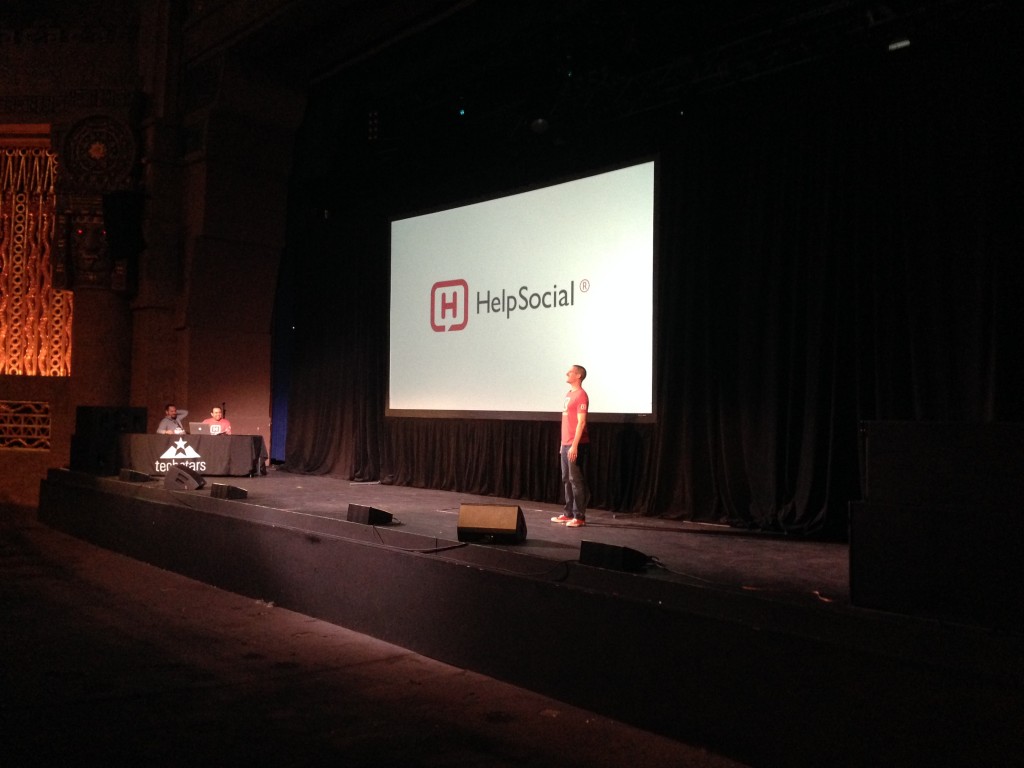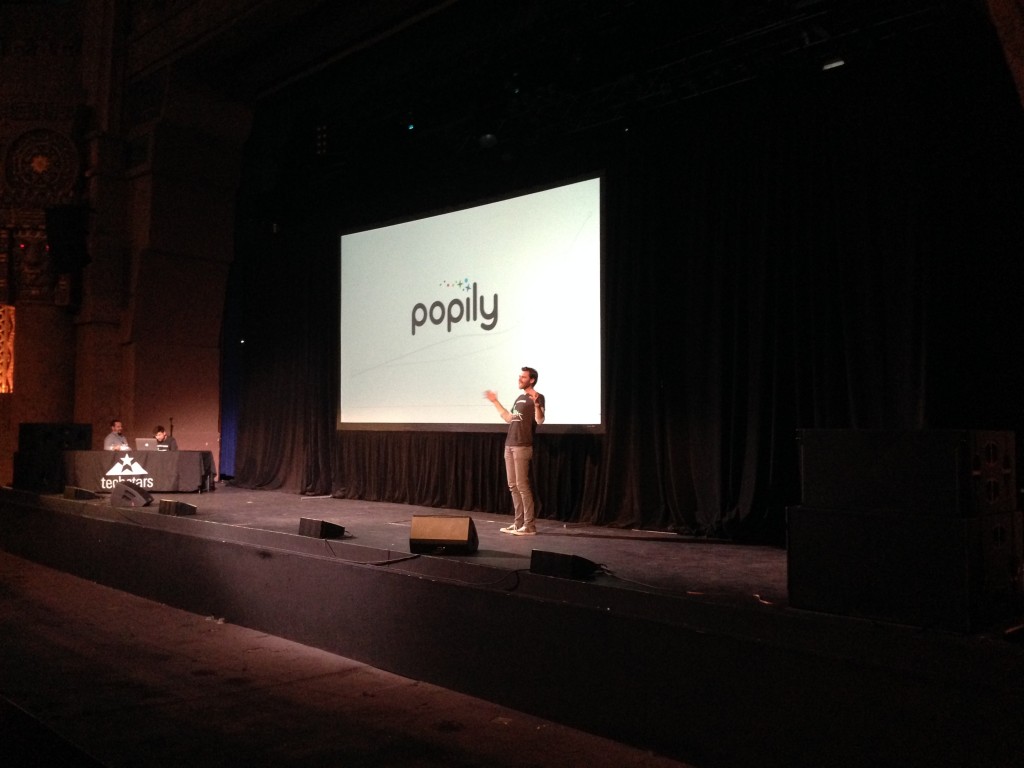
The 2016 Techstars Cloud Class at Techstars Demo Day at the Aztec Theater in downtown San Antonio.
By LAURA LOREK
Reporter with Silicon Hills News
At the Aztec Theater in downtown San Antonio, entrepreneurs with 11 startups took to the stage to present their companies during the fourth Techstars Cloud Demo Day Thursday afternoon.
The companies participating in Techstars go on to raise, on average, over $1.5 million during the course of their journey, said Dave Cohen, co-founder and CEO of Techstars. They have raised $2 billion in aggregate as they continue to grow their businesses, he said. The valuation of the 700 plus Techstar alumni companies is well over $5 billion, he said.
This year’s Techstars Cloud class came from four different countries and eight cities, said Blake Yeager, managing director of the Techstars Cloud. To date, 33 alumni companies completed the Techstars Cloud program and they have raised collectively $150 million in outside capital, Yeager said.

Matt Wilbanks, CEO of Help Social kicks off the pitches at Techstars Demo Day
The first company to present,
Help Social, spun out of Rackspace. It’s a “local, home grown San Antonio-based startup,” said Matt Wilbanks, CEO. He founded the company with Robert Collazo, Chief Technology Officer, in 2014. They raised seed stage funding from Mark Cuban and the Geekdom Fund.
Since its launch, Help Social has created a customer service platform that it licenses to companies to help them communicate with their customers through their social media feeds like Twitter, Facebook, YouTube and Instagram.
“Large consumer brands are facing a crisis with customer service. The way that customers interact with brands has evolved quickly and customer service platforms haven’t kept up,” Wilbanks said. “We live in an on demand mobile world where businesses no longer decide how or where they are going to interact with their customers.”
“Social media, in particular, has become a primary method of communication and it has given customers unprecedented control of the conversation,” Wilbanks said. “They now have this giant public megaphone where they can share a good experience with a product or they can bash a brand after a bad experience.”
Help Social’s platform helps companies keep up with the demands of social media and provide excellent customer service, Wilbanks said. It has eight call center companies using its platform currently, he said. The overall market for social media customer service is estimated to be worth $5 billion by 2020, he said.
HelpSocial has five employees based at Geekdom. But it plans to scale its operations to grow, Wilbanks said.

Sean Higgins, co-founder of ilos at Techstars Demo Day
Isaac Saldana, president of SendGrid, a Techstars alumni company with more than 300 employees, introduced the second presenter,
ilos, based in St. Paul, Minn. Ilos has solved a major problem for companies looking to document processes, he said. He is so impressed with the company he is also an investor in them.
Ilos created software tools to allow people to take videos of their computer screens, known as screen casting. Its mission is to bring more video into the workplace for training, sales, support and more, said Sean Higgins, co-founder and head of business development for ilos.
The current process of recording videos is fragmented, Higgins said. Ilos takes the traditional process of video creation and condenses it into one step, Higgins said.
“You can easily create, instantly share, while having all your content in one spot,” he said.
Ilos is already generating $20,000 in revenue monthly, Higgins said. It’s a storage and hosting business for videos too, he said. The company has 12 employees.
“And it’s just the beginning,” he said. “Why? Customers like the product.”

Jonathon Morgan, co-founder of Popily presents the data story telling tool at Techstars Demo Day
The third presenter,
Popily, a data story telling site, is one of the three companies participating in the latest cohort from Austin.
Popily is a software as a service company which turns data into easy to read charts and spreadsheets.
Jonathon Morgan, co-founder, said a lot of data is trapped in companies and they need a tool like Popily to access and analyze that data. The service just launched last month. In addition to Morgan, Vidya Spandana and Chris Albon are co-founders. The company charges between $9 to $59 a month to subscribers who use its software.
Next up, Austin-based startup, HuBoard touted its project management solution for users of GitHub and GitHub Enterprise.
Within six months of launching the service, HuBoard had 250 paying customers, said HuBoard CEO Ryan Rauh. Shortly after that, large enterprises wanted a version to work behind their firewalls, he said. Today development teams at Microsoft, Mozilla, Adobe and hundreds more are using HuBoard, he said.
“Without spending a dollar on marketing, we built this business to over $11,000 in monthly reoccurring revenue,” Rauh said.
The first international company to pitch, Jumble, presented its email encryption technology. The company is from Dublin, Ireland.
Fiona Kelly, chief operating officer of Jumble, gave an overview of the company’s business. Encryption is the solution to sending secure email, she said.
Unfortunately, encryption services today are hard to use. That’s the problem Jumble solves, she said. It makes it easy to send encrypted email for its customers inside Gmail, Outlook and even mobile devices, she said.
“An unsecured email is a serious business risk,” Kelly said.
Jumble charges companies $5 per user per month to use its email encryption software. Today, the company has more than 1,500 individual users and 400 company accounts in its beta trial, she said.
Rudy Ellis, CEO of Switchboard, pitched his Orlando-based startup which connects video and audio content creators with a platform of sponsors and brands. During the Techstars program, the startup changed its name from Joicaster to Switchboard.
“With Switchboard I get an audience that is ten times bigger and ten times more targeted than in the past,” Ellis said.
The company’s customers include Monster and Ted.com. Its platform ranges in cost from free to $30 a month and special pricing for enterprise customers.
The Techstars Cloud Demo Day also featured a little magic.
David Ortego, co-founder of Pomika, based in Malaga, Spain, a platform that turns images into shopping experiences, performed a few magic tricks on stage during his pitch. He used a black curtain to cover up a model and then dropped the curtain to reveal a different outfit. The act concluded with a white curtain and the model changing into a white evening gown.
Pomika is a cloud-based platform that sends users information about where they can purchase the items from images they post. Pomika makes a commission on each sales referral. It also changed its name during the Techstars Cloud program from Imagenii to Pomika.
One of the fastest growing startups, Clyp, based in Austin, has already reached more than one million unique users including a few high profile users like Eric Clapton, said Jordan Patapoff, co-founder. He founded the company in 2013 with Tyson Ferguson.
Clyp is a simple to use drag and drop platform that allows people to share audio files. Clyp takes music creation from an isolated process to one of collaboration, Patapoff said. Its Pro-Plan starts at $9 a month, he said.
The other companies included UXTesting, based in Taiwan, a toolkit to improve mobile user experiences using data visualization, Haste, formerly known as Thalonet, based in Atlanta, a private network to provide video game players with better performance on the Internet and Sage Hero, formerly Slash Sensei, an online training platform. Erik Larson, its CEO, announced Rackspace as a paid pilot customers at the event.
![]() Robert Scoble, who has worked in various roles with Rackspace for the past seven years, announced Thursday he is leaving the San Antonio-based tech company to join UploadVR.
Robert Scoble, who has worked in various roles with Rackspace for the past seven years, announced Thursday he is leaving the San Antonio-based tech company to join UploadVR.